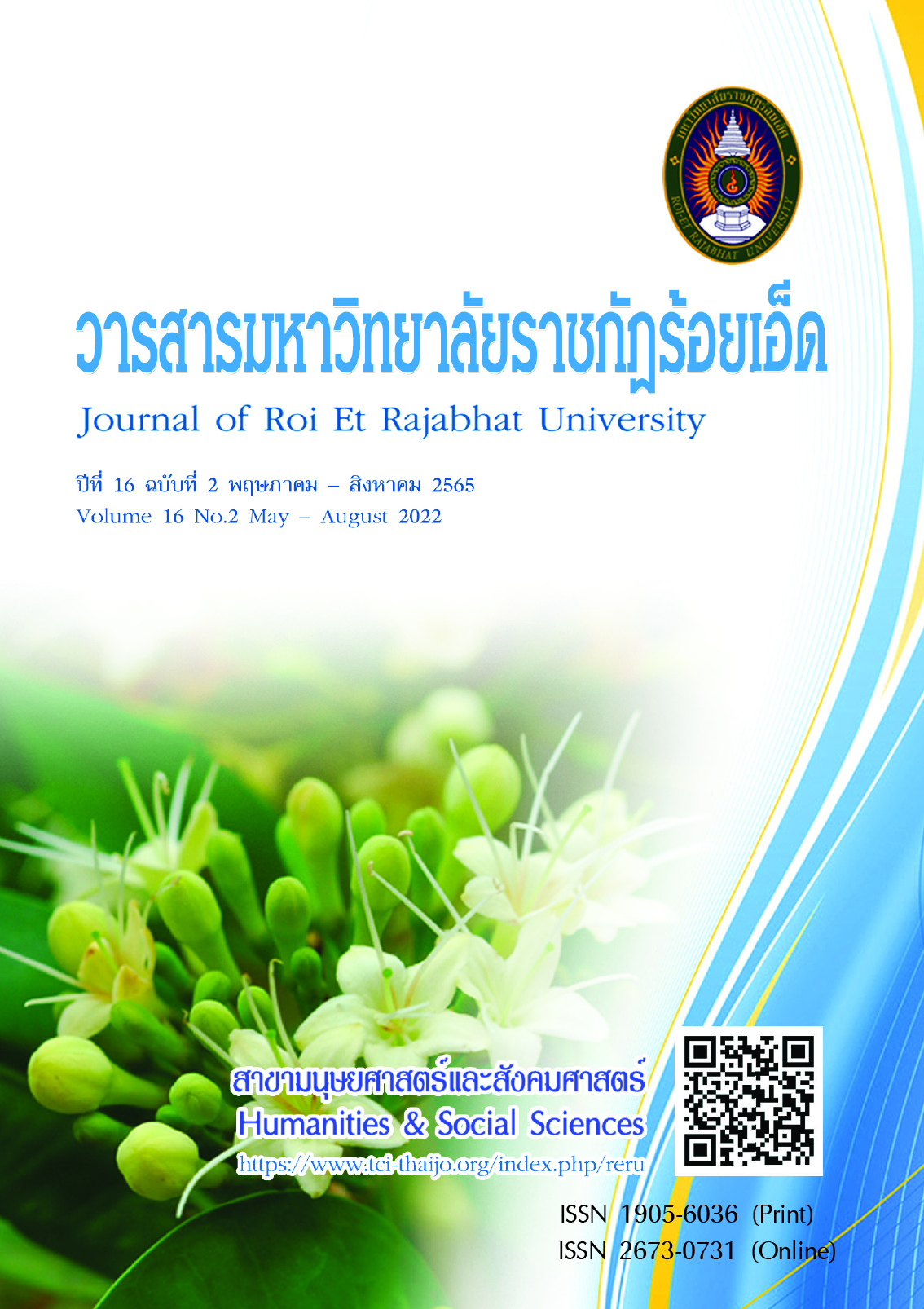The Effects of Numbered Heads Together (NHT) and Project-Based Learning to Promote Teamwork Skills of Thepsatri Rajabhat University Students
Keywords:
Numbered heads together, Project based learning, Teamwork skillAbstract
The purposes of this research were 1) to compare the learning achievement of students
after using Numbered Heads Together (NHT) and project-based learning, and 2) to compare the students’ teamwork skills between their pretest and posttest. The sampling was 37 students who enrolled
in Web-based Instruction Design in the 1st semester of the academic year 2020 at Thepsatri Rajabhat University by purposive sampling. The instruments for the study were 1) Pretest and Posttest and
2) Teamwork Skills Assessment form. The data were analyzed by arithmetic mean, standard deviation, and t-test.
The results of this research were 1) the learning achievement of students was higher at the .01 level of significance, and 2) the students’ teamwork skills after the implementation of NHT and project-based learning were significantly higher at .01 level, In consideration of each aspect, Voluntary and Willing
to Work, Equality in Work, Working Goal, Shared Responsibility, and Sharing Resources were significantly higher at .01 level of all aspects.
References
กัญญาภัทร แสงแป้น. (2562). การพัฒนารูปแบบการจัดการเรียนรู้โดยใช้โครงงานร่วมกับสื่อสังคมออนไลน์เพื่อเสริมสร้างทักษะการพูดเพื่อการสื่อสาร สำหรับนักศึกษาครู. ดุษฎีนิพนธ์ ศึกษาศาสตรปรัชญาดุษฎีบัณฑิต สาขาวิชาหลักสูตรและการสอน. กรุงเทพฯ: มหาวิทยาลัยศิลปากร.
ทิพวิมล ชมภูคำ และอภิชาติ เหล็กดี. (2560). ผลการจัดการเรียนรู้โดยใช้โครงงานเป็นฐาน เพื่อพัฒนาทักษะด้านการเขียนโปรแกรมในระบบเว็บสำหรับนักศึกษาระดับปริญญาตรี. รายงานสืบเนื่องการประชุมวิชาการระดับชาติ การจัดการเทคโนโลยีและนวัตกรรม ครั้งที่ 3. มหาวิทยาลัยราชภัฏมหาสารคาม.
มนต์ชัย เทียนทอง. (2554). การออกแบบและพัฒนาบทเรียนคอมพิวเตอร์. กรุงเทพฯ: ศูนย์ผลิตตำราเรียน สถาบันเทคโนโลยีพระจอมเกล้าพระนครเหนือ.
วัชรินทร์ โพธิ์เงิน, พรจิต ประทุมสุวรรณ และสันติ หุตะมาน. (2557). การจัดการเรียนการสอนแบบโครงงานเป็นฐาน. สืบค้นเมื่อ 20 กรกฎาคม 2563, จาก http://www.fte.kmutnb.ac.th/km/project-based%20learning.pdf
ศิริพล แสนบุญส่ง, ธันว์รัชต์ สินธนะกุล และกฤช สินธนะกุล. (2561). การสังเคราะห์รูปแบบการเรียนการสอนแบบโครงงานเป็นฐานผ่านสิ่งแวดล้อมทางการเรียนรู้บนคลาวด์คอมพิวติง เพื่อส่งเสริมผลงานสร้างสรรค์และทักษะการทำงานร่วมกันเป็นทีมของนักศึกษาระดับปริญญาตรี. วารสารวิชาการมหาวิทยาลัยราชภัฏภูเก็ต, 14(2), 299-324.
อรพรรณ คิอินธิ และไพบูลย์ ลิ้มมณี. (2562). การพัฒนาแนวทางการทำงานเป็นทีมของครูสำหรับสถานศึกษา สังกัดสำนักงานเขตพื้นที่การศึกษามัธยมศึกษาเขต 21. วารสารมหาวิทยาลัยราชภัฏร้อยเอ็ด, 13(3), 94-103.
Aksela, M. K. and Haatainen, O. M. (2019). Project-Based Learning (PBL) in practise: Active teachers’ views of its advantages and challenges. Proceedings of the 5th International STEM in Education conference: Integrated Education for the Real World. 9–16.
Alves, A. C., Mesquita, D., Moreira, F. and Fernandes, S. (2012). Teamwork in Project-Based Learning: engineering students’ perceptions of strengths and weaknesses. International Symposium on Project Approaches, S. Paulo. 26-27 July. Retrieved July 20, 2020, from http://hdl.handle.net/1822/36308
Autapao, K. and Minwong, P. (2018). Effects of basic character design and animation concepts using the flipped learning and project-based learning approach on learning achievement and creative thinking of higher education students. AIP Conference Proceedings 1923, 030003 (2018); https://doi.org/10.1063/1.5019494.
Çakici, Y. and Turkmen, N. (2013). An investigation of the effect of project-based learning approach on children’s achievement and attitude in science. The online journal of science and technology, 3(2), 9-17.
Child, S. F. J. and Shaw, S.D. (2016). Collaboration in the 21st century: Implications for assessment. Research Matters: A Cambridge Assessment publication, 22, 17–22. Retrieved July 20, 2020, from https://www.academia.edu/30976138/Collaboration_in_the_21st_century_Implications_for _assessment.
Indarti, D. and Pramudya, I. (2017, December). Numbered head together with scientific approach in geometry learning. In Journal of Physics: Conference Series, 943(1), 012028. IOP Publishing.
Lamhot N. (2019). The Effectiveness of Number Head Together Strategy on Improving Students’ English Achievement at XYZ School. International Journal of Research–Granthaalayah, 7(10), 362-370. DOI: https://doi.org/10.29121/granthaalayah.v7.i10.2019.406
Maman, M. and Rajab, A. (2016). The Implementation of Cooperative Learning Model ‘Number Heads Together (NHT)’ in Improving the Students’ Ability in Reading Comprehension. International Journal of Evaluation and Research in Education (IJERE), 5(2), 174-180. DOI: 10.11591/ijere.v5i2.4536.
Nasrun. (2016). The Use of Cooperative Learning With Number Head Together Model to Improve the Students’ Mathematics Subject. IOSR Journal of Mathematics (IOSR-JM), 12(5), 113-117. DOI: 10.9790/5728-120501113117.
Nursyamsi, S.Y. and Aloysius, D. C. (2016). The Effect of Numbered Heads Together (NHT) Learning Strategy on The Retention of Senior High School Students in Muara Badak, East Kalimantan, Indonesia. 10.5281/zenodo.154450. Retrieved July 30, 2020, from https://zenodo.org/record/154450#.YBV_zej7SUk
UNICEF MENA Regional Office. (2017). The Twelve Core Life Skills. Retrieved July 27, 2020, from http://education2030-arab-states.org/PDF/d816129f-5d08-40d1-9984-d587631e1b14_report1.pdf
Downloads
Published
How to Cite
Issue
Section
License
Copyright (c) 2022 Roi Et Rajabhat University

This work is licensed under a Creative Commons Attribution-NonCommercial-NoDerivatives 4.0 International License.
บทความที่ได้รับการตีพิมพ์เป็นลิขสิทธิ์ของวารสารมหาวิทยาลัยราชภัฎร้อยเอ็ด
ข้อความที่ปรากฏในบทความแต่ละเรื่องในวารสารวิชาการเล่มนี้เป็นความคิดเห็นส่วนตัวของผู้เขียนแต่ละท่านไม่เกี่ยวข้องกับมหาวิทยาลัยราชภัฎร้อยเอ็ด และคณาจารย์ท่านอื่นๆในมหาวิทยาลัยฯ แต่อย่างใด ความรับผิดชอบองค์ประกอบทั้งหมดของบทความแต่ละเรื่องเป็นของผู้เขียนแต่ละท่าน หากมีความผิดพลาดใดๆ ผู้เขียนแต่ละท่านจะรับผิดชอบบทความของตนเองแต่ผู้เดียว





